Are Your Cannabis Roots Healthy? Here’s How To Check
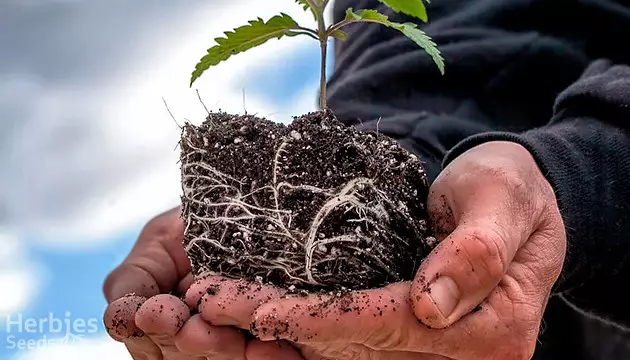
Starting from the moment your cannabis seed finally pops, its root becomes the basis of the young plant’s healthy maturing. As time passes, the root system never loses its importance in terms of the overall health of marijuana plants. Even though we can’t really see what’s happening in the dirt, there are ways to check on the health of your cannabis’ root system – and as soon as it falls victim to a disease or pests, the problem translates into clear signs both below and above the ground’s surface. In this article, we’ll be covering the importance of a healthy root system for cannabis health, as well as the main problems with cannabis roots that could put your harvest in danger –tips on solving each issue included. Let’s dive right in!
Function Of Cannabis Roots
The cornerstone of a healthy cannabis plant is healthy roots. The roots of your marijuana bushes are easily the most vital organ of your plants, as it’s from the roots that cannabis is able to sustain the essential process of photosynthesis. During the process of photosynthesis, carbon dioxide is converted into oxygen and sugars as your plant reacts to sunlight. The roots, in turn, feed on the oxygen from this process to keep your plant alive; oxygen and sugars then react to create ATP (adenosine triphosphate) energy, which provides energy to all living cells. It is this cyclic process in the roots that provides your plant with all the necessary energy to grow. Also, don’t forget that it’s through the root system that cannabis receives the nutrients from the soil, starting from the vital nitrogen, potassium, and phosphorous and finishing with micronutrients like iron, magnesium, zinc, etc.
How To Check If Your Plant's Roots Are Alright
The health of your roots ultimately determines the health of the flowers your plant produces. First of all, if you can check the roots of your cannabis plant, pay attention to their color. Healthy cannabis roots are always creamy or white in color, with no sliminess or discoloration.

Moreover, even though cannabis roots are responsible for nutrient intake, nutrient deficiencies are mostly visible in the leaves of the plant, not the roots. For example, nitrogen deficiency can be seen in yellowing and brown spots, phosphorous deficiency causes blue-green, dark purple, or dark copper leaves, potassium deficiency results in dark green leaves and leaf burn, etc. It’s therefore important to keep an eye on your leaves to make sure your roots are healthy and in the perfect condition to absorb all necessary nutrients.
Before we move on to dissecting common cannabis root problems, just know that it’s always a good idea to prevent most of these problems by using perlite, vermiculite, peat moss, and compost teas to provide nutrients and fluff up the soil, making it easier for natural microbes and critters to move around. Use complete soils to encourage symbiosis between fungus, insects, bacteria, and your plants; these keep the soil loose so that it’s easier for the roots to absorb water and oxygen and grow freely.
Common Root Problems And How To Solve Them
Your cannabis roots can be very easy to manage, but without proper care, they can also be susceptible to a myriad of health problems. Tangled or dead roots, moldy soil, and invasive pests are all common problems to watch out for as you raise your marijuana seedlings to budding stalks. Here are some common issues to be aware of when growing your own cannabis plants.
Tangled Cannabis Roots And “Root-Bound” Cannabis Plants
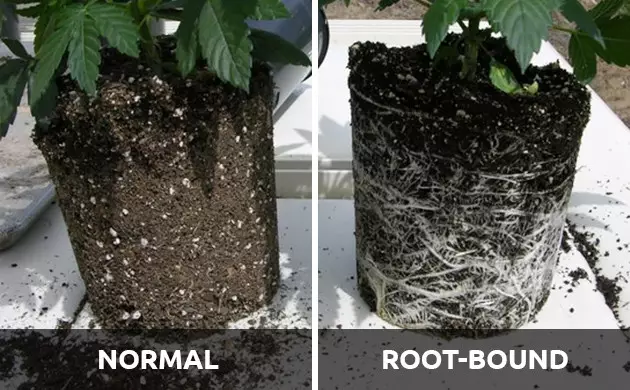
If your roots become too cramped in their living space, they can tangle up and strangle themselves, depriving themselves of oxygen. This is what’s known as becoming root-bound. Root-bound plants are unable to take in the necessary oxygen for their survival; they can then die off, possibly killing the entire plant. Root-bound plants typically suffer from stem discoloration (reddening), stunted growth in the plant, and slowed growth in flower production. Your roots need plenty of space to grow, so make sure your plant is always in a big enough pot. If your roots are blocking the drainage holes at the bottom of your pot, it's time to transplant!
Watering Issues Affecting Cannabis Roots
It’s important to ensure that your cannabis plants are getting the right amount of water. Overwatering your marijuana plants can lead to serious problems in their root network such as root rot, so make sure to let the soil dry completely between waterings. To avoid watering issues, make sure you use pots made of porous material so the soil is able to breathe; pots should also have a proper drainage system. Of course, you should also make sure your plants are in appropriately-sized containers. If your plant needs watering once or more a day, it could be time for a transplant.
Wrong pH Of Your Soil Or Other Growing Media
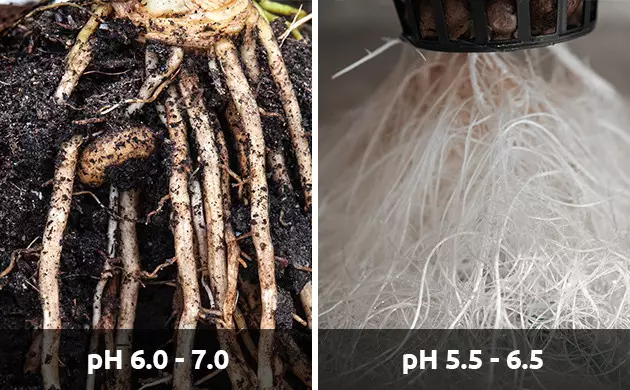
Cannabis plants need healthy soil to thrive, which also means having the correct pH levels. pH is a measurement of how acidic (0) or basic (14) a substance is. For soil and soil-like systems, the pH should be between 6.0 and 7.0, with 6.3 being the ideal. For hydroponic systems, the range is 5.5 to 6.5, with each of these systems having a different ideal point. If your pH is too acidic or too alkaline, your roots cannot properly intake nutrients, which can cause a plethora of nutrient deficiencies that are detrimental to plant health. So, make sure to always check the pH of both the soil and the water you use for feeding the roots.
Root Rot
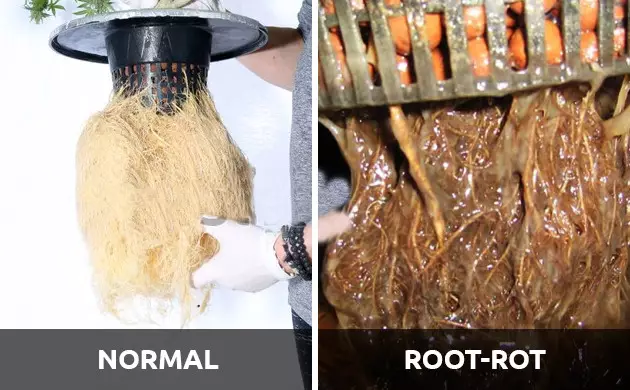
Root rot in cannabis is a sickness your plants can get if they become root-bound, are overwatered, or lack sufficient drainage and can therefore no longer take in oxygen. When roots begin to rot, the entire plant becomes at risk of dying. Healthy roots should be visibly white or cream-colored, with no sliminess, darkening, or discoloration. Cannabis root rot is much easier to prevent than it is to treat. To avoid cannabis root rot in the soil, make sure your plants are in proper containers to avoid becoming root-bound. Also ensure that you have healthy soil with a proper network of healthy microbes and bacteria, particularly mycelium, which helps nutrients become more easily available to the roots. Most importantly, don’t overwater your plants, because once rotten, the roots won’t recover - that’s why most growers choose to discard plants infected with root rot completely.
Cannabis Roots Infected By Fungus Gnats And Root Aphids
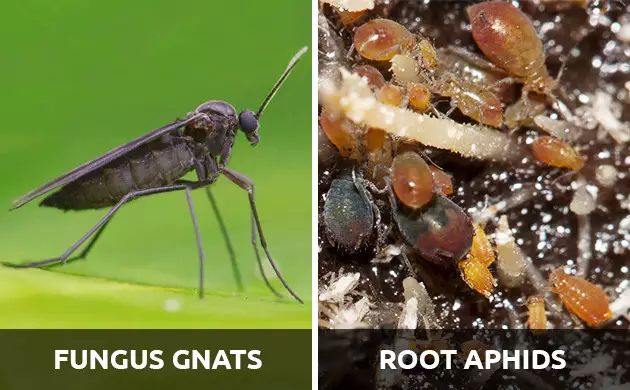
Fungus gnats are tiny gray or black long-legged flies, usually resembling mosquitoes, which can feed on your plants. Fungus gnats lay eggs in the soil of cannabis plants, the larvae of which are highly intrusive and feed on the roots, organic matter, and healthy fungi in your soil. This can quickly make your weed plant wilt and even die if you don’t act soon enough.
Root aphids, another tiny white bug living in soil, are also a common pest in cannabis plants and are commonly confused with fungus gnats. However, root aphid symptoms cause yellowing, swelling, and hardening of the plant roots, in contrast with the pale foliage and general flimsiness of fungus gnat symptoms.
Insecticides seem to be the best way to rid your roots of both gnats and aphids. In addition, be sure to keep your humidity low and not overwater your plants.
Final Word On The Health Of Cannabis Roots
Everyone expects their cannabis plant to yield bountiful harvests of resinous buds. Unfortunately, this is impossible if cannabis roots aren’t taken good care of. As you’ve learned today, their inspection and the maintenance of good quality soil and other growing media is key if you want to keep marijuana roots, and therefore the whole plant, happy and healthy. Most problems with cannabis roots are much easier to prevent than to actually deal with, so once you plant your seed, don’t forget to come back to this article to check if you’re giving your cannabis roots everything they need to thrive.
Herbies Head Shop expressly refuses to support the use, production, or supply of illegal substances. For more details read our Legal Disclaimer.

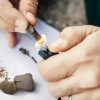







Thank you for leaving a comment for us!
Your feedback will be posted shortly after our moderator checks it.
Please note that we don’t publish reviews that: